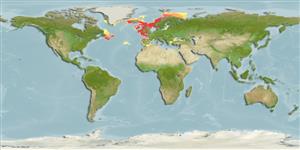Environment: milieu / climate zone / depth range / distribution range
Ecologie
marien demersaal; oceanodroom (Ref. 51243); diepte 100 - 1000 m (Ref. 35388), usually 100 - 400 m (Ref. 35388). Temperate; 75°N - 35°N, 55°W - 44°E (Ref. 54595)
Northwest Atlantic: off southern Greenland and Canada. Northeast Atlantic: Barents Sea and Iceland to Morocco. Mediterranean Sea: northwestern Mediterranean only.
Lengte bij maturiteit / Grootte / Gewicht / Leeftijd
Maturity: Lm 92.5, range 90 - 100 cm
Max length : 200 cm TL mannelijk / geslacht onbekend; (Ref. 1371); common length : 106 cm TL mannelijk / geslacht onbekend; (Ref. 1371); max. gepubliceerd gewicht: 45.0 kg (Ref. 35388); max. gerapporteerde leeftijd: 25 Jaren (Ref. 35388)
Dorsale stekels (totaal): 0; Dorsale zachte stralen (totaal): 75-83; Anale zachte stralen: 58 - 64; Wervels: 63 - 65. Upper jaw projecting beyond lower one. Color is reddish brown dorsally, grading to white ventrally. The posterior areas of the vertical fins dark with pale margins. The sides distinctly marbled (Ref. 232). Barbel is present in the chin, longer than the diameter of the eye. Black spot in the rear end of the first dorsal fin. Caudal peduncle stout compared to blue ling (Ref. 35388).
Occurs mainly on rocky bottoms in fairly deep water (Ref. 9988). Found more commonly from 100 to 400 m. Feeds on fish (cod, herring, flatfish), lobsters, cephalopods and starfishes. Principal spawning areas are Biscay, slopes west of the British Isles and off the Faeroes and southern Iceland (Ref. 35388). Marketed fresh, dried or salted and frozen; eaten steamed, fried, broiled and baked (Ref. 9988).
Major spawning grounds are located at 200 m depth from the Bay of Biscay to the Gulf of Norway at 100 to 300 m off southern Iceland, and at 50 to 300 m in the Mediterranean Sea. Fecundity may reach 20 to 60 million eggs per female (Ref. 1371).
Cohen, D.M., T. Inada, T. Iwamoto and N. Scialabba, 1990. FAO species catalogue. Vol. 10. Gadiform fishes of the world (Order Gadiformes). An annotated and illustrated catalogue of cods, hakes, grenadiers and other gadiform fishes known to date. FAO Fish. Synop. 125(10). Rome: FAO. 442 p. (Ref. 1371)
Status op de Rode Lijst van het IUCN (Ref. 130435)
Gevaar voor de mens
Harmless
Gebruik door de mens
Visserij: van groot commercieel belang; sportvis: ja
Meer informatie
ReferentiesAquacultuurAquacultuurprofielKweeklijnenGeneticaElectrophoresesErfelijkheidZiektesVerwerkingNutrientsMassaconversie
Tools
Speciale rapporten
Download XML
Internetbronnen
Estimates based on models
Preferred temperature (Ref.
123201): 4.6 - 11.3, mean 7.7 °C (based on 438 cells).
Fylogenetische diversiteitsindex (Ref.
82804): PD
50 = 0.6250 [Uniqueness, from 0.5 = low to 2.0 = high].
Bayesian length-weight: a=0.00389 (0.00241 - 0.00628), b=3.06 (2.92 - 3.20), in cm total length, based on LWR estimates for this species & (Sub)family-body (Ref.
93245).
Trofisch niveau (Ref.
69278): 4.4 ±0.2 se; based on diet studies.
Weerstandsvermogen (Ref.
120179): Gemiddeld, minimale populatieverdubbelingstijd 1,4-4,4 jaar (K=0.12; tm=5-6; tmax=25; Fec=60 million).
Prior r = 0.51, 95% CL = 0.34 - 0.77, Based on 7 stock assessments.
Fishing Vulnerability (Ref.
59153): Very high vulnerability (77 of 100).
Climate Vulnerability (Ref.
125649): Moderate vulnerability (38 of 100).
Nutrients (Ref.
124155): Calcium = 15.2 [7.4, 33.3] mg/100g; Iron = 0.278 [0.140, 0.600] mg/100g; Protein = 17.7 [15.9, 19.4] %; Omega3 = 0.368 [0.197, 0.685] g/100g; Selenium = 32.5 [16.9, 66.3] μg/100g; VitaminA = 8.35 [2.10, 31.25] μg/100g; Zinc = 0.28 [0.18, 0.44] mg/100g (wet weight);
